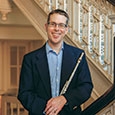Most professional musicians I know wish they had more time to practice. As a college professor with an active performing schedule, I often find it necessary to fit it in whenever I have five minutes to spare. Between concerts, teaching, composing, committee meetings, travel, and the necessity of being one’s own agent and personal secretary, practicing can sometimes feel like merely surviving the next gig. But, there are ways to make it enjoyable. When it comes time to reevaluate how I am spending my practice time it is fun and useful to daydream about what I would do if I had an extra hour every day for three months devoted only to flute playing.
Normally, my practice material is not the same every day. I tend to focus on the specific skills I need for upcoming performances. So, an extra hour would include mostly foundational work on technique and also some repertoire.
I would devote the first month to Paul Edmund Davies’ The 28 Day Warmup Book. The exercises are divided into sections on tone, technique, articulation, and intervals, while emphasizing control of dynamics and intonation in all registers. Following Davies’ four-week schedule will keep flutists in good playing shape. They are a good test of one’s abilities, and it is often challenging to play them cleanly at the recommended metronome markings. Working through four exercises (one exercise in each category) per day, with all repeats, takes just about a full hour.
Moyse’s Tone Development Through Interpretation would form the basis for work during the second month. This popular volume contains beautiful melodies mostly from the opera repertoire. I love to sing them first and then try to recreate the same phrasing inflections on the flute. The goal is to keep the air supported to create a smooth line without bumps. Choosing one or two per day, it is possible to make them as beautiful as possible as written and then transpose them by ear into various other keys. If I find a melody I am not familiar with, I work with it for a while on my own before finding recordings by great singers and instrumentalists for comparison. Hearing the greatest musicians past and present is a wonderful way to become inspired and keep one’s musical ideas fresh.
Technique work during the second month would center on Michel Debost’s Scale Game, an ingenious regimen of practice for the fourth of Taffanel and Gaubert’s Seventeen Big Daily Exercises. The 60 combinations of keys with variations in tempo, articulation, rhythm, and dynamics can keep anyone occupied for far longer than a month. The challenge is to play the scales musically, with the best sound and rhythm, no matter the pattern. Finishing all of the keys with their permutations brings a true sense of accomplishment.
The third month’s practice sessions would start with different types of long tone exercises (with and without vibrato, forte and piano, crescendo and diminuendo), practiced with different types of attacks (bell tones, accents, niente, etc.) in different registers at varying dynamic levels. This helps develop and maintain consistency, something I need every day since I often do not have time to do my entire warmup routine in the morning. For this I make up my own exercises that are often based on the ones in Moyse’s De La Sonorité. I find that just a few minutes of careful practice on these can produce a profoundly positive result, especially later that day. I would also focus on etudes, particularly Andersen’s Opus 60, Paganini’s Caprices, Karg-Elert’s Caprices, and etudes by Jeanjean, Casterede, and others. I might also include a bit of piccolo practice on certain of these passages.
For the rest of the hour, I would begin reading through the many works composers have sent me over the years. I have quite a stockpile of interesting pieces in many different contemporary styles that would be fun to play. Admittedly, I would probably need the full three months and more for this endeavor, but finding the compositional gems would be well worth the effort.
Finally, if there is any time left, I would love to begin learning and memorizing some standard solo and orchestral repertoire I have never performed. To this day I still have not performed all the pieces in Flute Music by French Composers, for example as well as certain Handel sonatas. I also have not learned all of Stravinsky’s major orchestral works. It will take a lot longer than three months to absorb all of the great music I have neglected, so now it is time to go practice.






